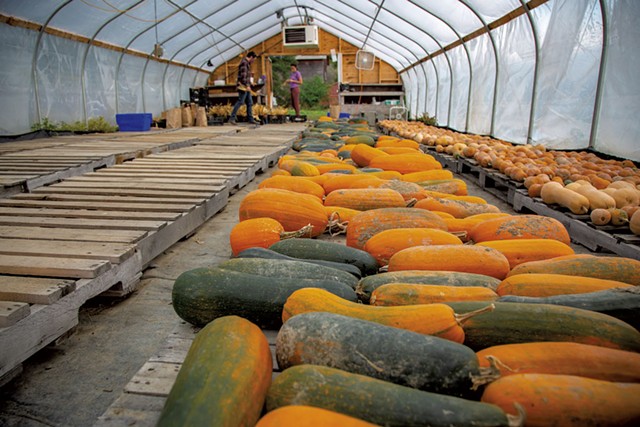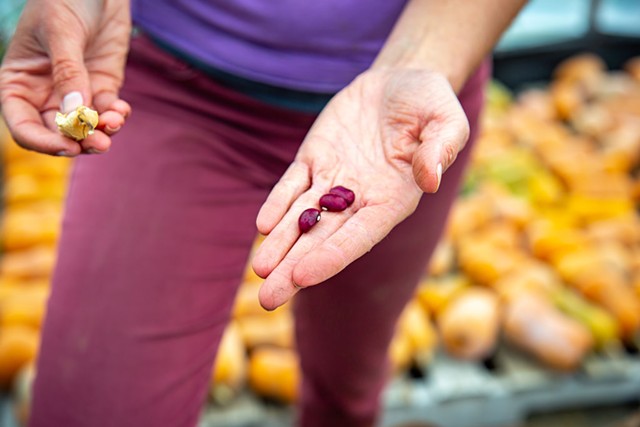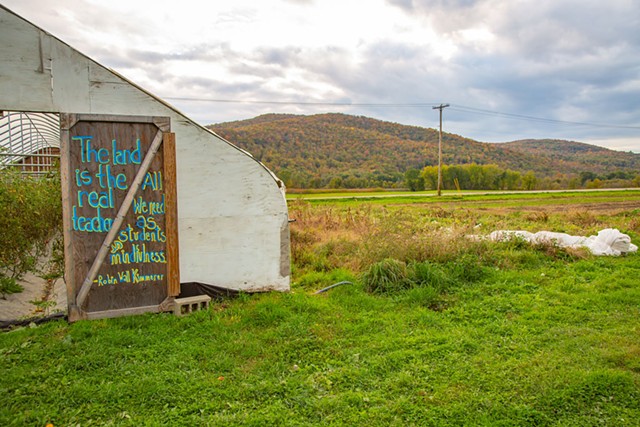On an early October day at the Vermont Youth Conservation Corps‘ Farm in Richmond, an empty greenhouse was quickly filling with the year’s harvest.
“It’s really tangible today, to see all the food come in,” said Livy Bulger, education and engagement manager at the Northeast Organic Farming Association of Vermont. She was unloading an armload of Algonquin squash. Hundreds of pounds of the hefty oblong squash lined the length of the greenhouse, forming a gradient from zucchini-like dark green to vivid orange.
Squash was one of the crops grown in the pilot year of the Abenaki Land Link Project, a partnership of the Nulhegan Band of the Coosuk-Abenaki Nation, NOFA-VT and the Vermont Farm to Plate Network’s Rooted in Vermont program.
More than a dozen farmers, gardeners and homesteaders around the state received Indigenous seeds provided by the Nulhegan Band — for Algonquin squash; cranberry, skunk and Mohawk dry beans; Calais flint corn; and a Koasek/Calais corn mix — to grow and harvest for Abenaki citizens.
The project started with a conversation last November, explained Farm to Plate communications manager Shane Rogers as he stacked crates of corn whose colors rivaled the peak foliage outside. Rogers and Don Stevens, chief of the Nulhegan Band, were discussing Stevens’ food sovereignty work.
“In that conversation, it came up that he would love to partner with farms to grow food for his citizens,” Rogers said. From there, Rogers reached out to Bulger, and the partnership was formed.
“We put our heads together and figured out how to very easily do it with a quick sign-up [at the NOFA-VT Winter Conference in February], and then have been very intentionally building the framework for what this looks like from there,” Rogers said.
When the Nulhegan Band acquired tribal land in Barton in 2012, one of the motivators was the ability to grow food for its people, Stevens explained over the phone last week.
“The first thing you need is recognition,” he said. “The second thing you need is your land. Then you need to be able to have some way to provide for your people.”
Stevens renewed his focus on helping his people access healthy, nutritious foods after the results of a Vermont State Health Assessment project confirmed what he already knew: The Abenaki were among the most vulnerable populations for diabetes and heart disease.
The tribe had established gardens in Barton, but the forested land was not well suited to food production. Stevens decided to seek out a partner to help grow their Indigenous crops, first working with Sterling College and Fred Wiseman’s Seeds of Renewal project in 2018 to establish the Dawnland Heritage Garden. That partnership led to the creation of the Dawnland Heritage Seed Library in 2019; the same year, Stevens also partnered with Middlebury College for a similar program.
In 2020, the work has expanded to the University of Vermont and the Abenaki Land Link partnership with NOFA-VT and Rooted in Vermont.
These food-security programs follow a similar timeline, Stevens explained. In the first year, the focus is growing the crops to increase the quantity of seeds available for these rare Indigenous crops and create a seed bank. The second year typically starts to yield enough food to distribute it to tribal citizens throughout the winter.
In its first year, the Abenaki Land Link Project has a few additional goals. By partnering with independent landowners around the state, it creates opportunities to educate growers about Indigenous Abenaki crops while building relationships.
Stevens hopes that those relationships might develop into a “phase two” for the project: access to land for the Nulhegan people to hunt, fish, and gather food and medicine without owning the land.
“It’s a great way to give back to a community who are always at a disadvantage,” Stevens said of the project as a whole. “Our population has always struggled. My goal, as chief, is to give our citizens access to that healthy food and help with our health disparities.”
But the partners are clear that the project isn’t charity; it’s an equal partnership that benefits the growers, too.
“There’s education from all angles and lenses,” Bulger said. “It’s not just ‘We grow this food, and it fills your plate.’ These farmers and homesteaders and gardeners are learning about Abenaki varieties and growing techniques.”
“Everybody’s here with the recognition of the horrific history that was here in Vermont among European settlers and the Indigenous population,” Rogers added. “We really tried to have our growers — who were all white landowners — recognize they are stewards of the land now that was once stewarded by Indigenous people, and they have an opportunity to grow food that is not currently available for all Indigenous folks, here in Vermont especially.”
In that vein, the seeds that were distributed to be grown are owned and provided by the Nulhegan Band. They represent the rich culture of the Abenaki people and the care that has been taken to preserve them over centuries, Stevens said. Retaining ownership of the seeds lets the Nulhegan Band “continue that stewardship without other people appropriating another thing from us.
“Those seeds were given to us by our creator to take care of us,” he said. “When we look at one of our seeds and we touch it, we are looking at the stories of the corn mother who sacrificed herself to get the seeds from her creator to be able to feed her children forever.”
The fact that the seeds exist at all is the result of thousands of ancestors caring for them, year after year, Stevens said.
“If any one of those people had not been a steward of those seeds and had thrown them away, we wouldn’t have them in our hand to be able to grow. It is our responsibility to continue those seeds forward for the next generations.”
Because the Indigenous crops are well suited to Vermont’s growing conditions, building these seed banks is also a measure against the threat of the climate crisis. The corn, for example, can grow in just 65 days. Stevens is considering the potential to create new crops — crossing quick-growing varieties, such as the Koasek corn, that are suited to shorter growing seasons with a different variety that produces bigger ears — to produce more food in a condensed amount of time.
“They would still be Indigenous foods,” Stevens said, “But we’d be creating something with the technology we have now — not just for us but maybe in the future for others, too.”
At the Farm at VYCC, the farmers were using an ancient Indigenous technology to grow the seeds they received as part of the Abenaki Land Link Project: the “three sisters” growing system, which involves growing corn, beans and squash together in one bed.
“It’s a way for these three crops to work together to prevent weeds, and the beans trellis up the corn,” said Jill Brooks, community engagement project lead at the Farm at VYCC. “It’s a very holistic way of growing food that I think Western ways of growing food aren’t necessarily as good at. I think we can learn a lot — and also owe a lot — to these methods of farming.”
Brooks explained that NOFA-VT had reached out to the corps farmers to see if they’d be interested in offering space and energy to be part of the Abenaki Land Link Project. For the youth education organization, the opportunity to teach people about the fact that Vermont — and the farm — is situated on unceded Abenaki territory was important, and the farm itself is starting to consider its role in that history, Brooks said.
The farm’s plot was the largest planted as part of the project (they ranged from small individual gardens to about a quarter acre). The beans were still in the field in early October, nearly ready to harvest.
“It’s all so beautiful. The beans are like jewels, and the corn is so vibrant,” Brooks said. “It’s been really cool to see foods that are Indigenous to this land growing here and to be able to experience that and appreciate it.”
The produce collected from the Farm at VYCC and the other growers around the state will be processed and distributed to citizens of the Nulhegan Band this winter. The project is partnering with Joe Bossen of Vermont Bean Crafters in Waitsfield to use winter squash processing equipment. The Algonquin squash will be peeled and sent through Bossen’s cubing machine before being packaged in one- and two-pound bags, vacuum-sealed, and frozen.
The corn will be removed from the cob and milled into flour with help from Adam Wilson of Running Stone Bread and Brush Brook Community Farm. The beans, which need time to dry in the greenhouse, will eventually be packaged into one-pound bags.
The Abenaki Land Link Project already has a waiting list for growers for next year, Bulger said. The partners hope to involve more commercial farmers so they can continue to scale up while still working with smaller-scale homesteaders and gardeners to support the educational mission.
“People are really hungry for this kind of work,” Bulger said.
The project partners had originally envisioned ending its first year with a harvest celebration; they wanted to invite the public to see the bounty produced around the state, watch processing demonstrations, listen to Abenaki stories and share a meal. COVID-19 put a damper on those plans for this year, but it hasn’t otherwise affected the project’s success.
“How wonderful is that?” Stevens remarked. “We can come together, even during COVID, where people can grow on their farms and then share the wealth with others in need. It was individually done, but we came together in a communal way, just like our ancestors did.”


